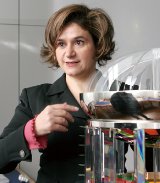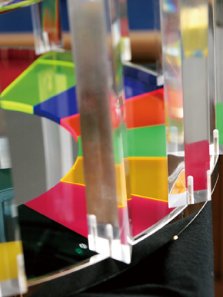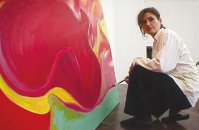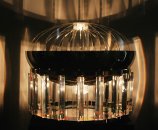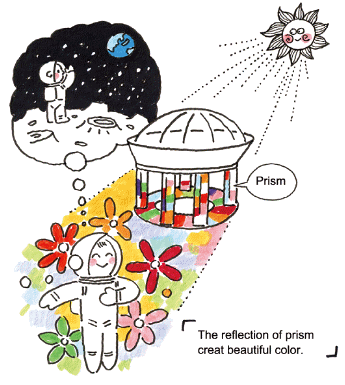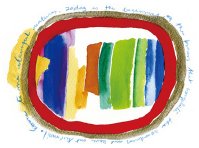| Transmutation of light and colour "And the tribe of birds are derived by transformation, growing feathers instead of hair, from men who are harmless but lightminded- men, too, who, being students of the worlds above, suppose in their simplicity that the most solid proofs about such matters are obtained by the sense of sight." Plato, Timaeus (91d) 1. This project was inspired by the lightness of the white light of the taraxacum officinale, common dandelion, a medical plant whose flower matures into a globe of filaments distributed by wind, carrying away the seed-containing achenes. The inner bracts are erect until the seeds mature, then flex down to allow the seeds to disperse. The wind easily disseminates the seeds and its fall is supported by wings of very thin filaments. This fragile plant suggests a winged bridge between the qualities of flight and sky and the stabilitiy of the earth. Its roundness recalls the unity and multiplicity of the sphere and symbolically represents the ephemeral condition of of human kind, "the shadow of a dream" (Pindar) and in its formation, similar to leaves (Homer). It also symbolizes the multiplicity of natural entities unified by the nurturing centre that feeds and guarantees the survival of the species.
The wind inspires (pnêuma) and supports (ánemos) the journey of humankind in helicoidal circle to death and the regeneration in the still womb of the Mother Goddess Deméter, similar to the grain of wheat that dies to be reborn multifructified and thus perpetuates the value of life. As symbol of "expansion" the dandelion is a synthesis of the human act of Prometheus in knowledge and transformation of the cosmos despite the cost to be paid for progress. In fact as Camoens states in The Lusiads (IV, 5-8) "but now there is no undertaking so daring, or so accursed, / be it through fire, water, heat, cold or the sword, / that man will leave it untried." (trans. William C. Atkinson) 2. The connotation to the ephemerality of that flower -the dandelion- that is destined to fly, generates a new idea- the birds, and in particular the human being who, like Daedalus, rise to the air not dispensing rest and safety of homeland. 3. Finally the idea of the macrocosmos appeared and emerged as counterpoint to the human being- the microcosmos. 4. The Project I present for Birdhouse is inspired by these concepts and has three distinct but converging parts: the first is the basis, terrestrial and more sensorial, the second crosses horizontality with verticality and prepares for the flight of the creative mind, and the final part raises to the ultimate aim of the transitory passage through the cosmic universe, and when its image is projected establishes an analogy to the Roman Pantheon - the architectural tribute to light.
5. The object represents the material basis on earth and indicates the fundamental condition of the diversified existence, such as the colour circle in a palette of 18 colours that in relationship with matter and light acquire the qualities of translucency, opacity, transparency, iridescence and reflection.
The 18 prisms correspond to 18 time zones of 15o that the sun covers daily and on a clock face to the time span of 0h to 9h, symbolic of the 9 months of the full cycle for the birth of the human being. These prisms are pillars that separate light into rainbows and change the colours seen through them mixed with the other colours of the reflection of the two-mirrored surfaces, and the colours they have as we move in all directions suggest the multiplicity of possibilities that colour and light provide in nature.
What we see every time we shift point of view are fluctuating planes and fragments thrust on sets of surfaces that differ in material but have in common qualities that permeate multiple mutations of colours that in turn are fluid and mingle continuously.
The ephemeral character of each viewing possibility is coupled by the top part of the object where the surfaces penetrable by light and sight work as pluridimensional membranes that dissolve and change with ethereal character.
The object resonates two major breakthroughs in the history of light and colour. Newton's experimentum crucis where a ray of light passing through a prism is broken down into the colours and by reversing the prism, the dispersed light is recombined into white light demonstrating that white light is the result of the addition of all the colours of the spectrum. With these seven colours he created the first colour circle (Aureus, Flavus, Viridis, Caeruleus, Indicus, Violaceus and Rubeus). Looking through the same prism, Goethe revealed that colours (the "actions and passions of light") are seen wherever a variation of light and dark occurs giving rise to a boundary.
In the object the prisms are also conceived as pillars that represent the sustained universal existence reflected on the mirrored surface of the calotte due to the genetic light (phôs ek photós) as a vault with wings irradiating from the centre cylinder: a thólos in praise of the divine light of creation and essence of beings and as a spaceship that with its movement involves us in temporal change and by tao- in the immobility of the eternal. | |


